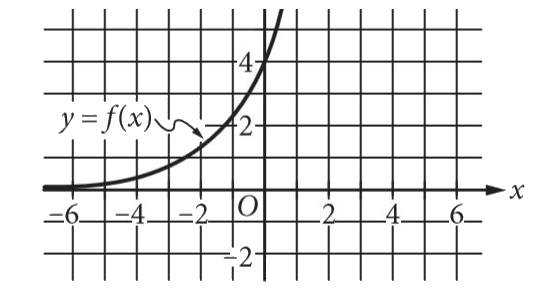
The graph of y = f (x) is shown in the xy -plane. What is the value of f (0) ?
0
2
3
4
The correct Answer is:D
Since y = f (x ), the value of f (0) is equal to the value of f (x ), or y, when x = 0. The graph indicates that when x = 0, y = 4. It follows that the value of f (0) = 4.
Choice A is incorrect. If the value of f (0) were 0, then when x = 0, the value of f (x ), or y, would be 0 and the graph would pass through the point (0, 0). Choice B is incorrect. If the value of f (0) were 2, then when x = 0, the value of f (x ), or y, would be 2 and the graph would pass through the point (0, 2). Choice C is incorrect. If the value of f (0) were 3, then when x = 0, the value of f (x ), or y, would be 3 and the graph would pass through the point (0, 3).
Similar Questions
The equation of straight line shown in figure is :
ltimg src="https://d10lpgp6xz60nq.cloudfront.net/physics_images/ALN_PHY_R04_E01_020_Q01.png" width="80%"gt01:59View SolutionAt x=0, value of (dy)/(dx) is : ltimg src="https://d10lpgp6xz60nq.cloudfront.net/physics_images/ALN_PHY_R04_E01_024_Q01.png" width="80%"gt
01:50View SolutionWhat is the distance OA for the square shown in figure :- ltimg src="https://d10lpgp6xz60nq.cloudfront.net/physics_images/ALN_PHY_R05_E01_015_Q01.png" width="80%"gt
01:19View SolutionFor shown situation find ∠BCA :-
ltimg src="https://d10lpgp6xz60nq.cloudfront.net/physics_images/ALN_PHY_R05_E01_035_Q01.png" width="80%"gt01:32View SolutionFind the magnitude of the resultant of shown forces :-
ltimg src="https://d10lpgp6xz60nq.cloudfront.net/physics_images/ALN_PHY_R02_E02_009_Q01.png" width="80%"gt04:05View SolutionAt x=0, value of dydx is :
ltimg src="https://d10lpgp6xz60nq.cloudfront.net/physics_images/ALN_PHY_R04_E01_024_Q01.png" width="80%"gt02:34View SolutionWhat is the distance OA for the square shown in figure :- ltimg src="https://d10lpgp6xz60nq.cloudfront.net/physics_images/ALN_PHY_R05_E01_015_Q01.png" width="80%"gt
01:45View SolutionFor shown situation find angleBCA :- ltimg src="https://d10lpgp6xz60nq.cloudfront.net/physics_images/ALN_PHY_R05_E01_035_Q01.png" width="80%"gt
01:44View Solution

